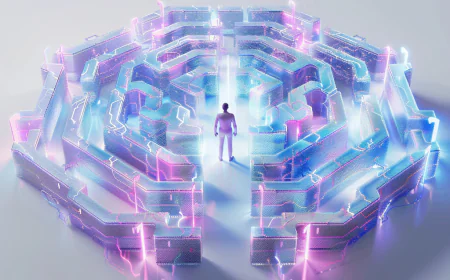Relationship Architecture: A New Approach to Networking
Summary & Description (Meta Tag): Discover a modern alternative to traditional networking. This comprehensive guide explores building sustainable relationships through value creation, social capital, and automated ecosystems, ideal for professionals seeking authentic connections and long-term success.

Relationship Architecture: A New Approach to Networking
Introduction: Why Do We Need a New Approach?
A large portion of people believe that success is directly linked to networking. It seems that if you don't attend business events, don't distribute business cards, and aren't constantly engaged in "clever small talk," career opportunities will pass you by.
This approach is a product of 20th-century business culture, where possessing connections often meant possessing power. But in the 21st century, in the era of information abundance and digital presence, this approach is becoming less and less effective. Today, people build trust not only on personal relationships but also on how visible you are, what you share, how you think, and what you create.
Relationship architecture is a different path: here, you don't try to "collect" relationships. Instead, you create a system that builds connections on your behalf. You create an environment where people come to you themselves because they trust you, see value, and want to become part of it.
The goal of this blog is to show you how to build such a system. Each chapter will help you understand step by step:
- Why traditional networking is an exhausted model;
- What social capital is and how it really works;
- How your actions can automatically attract the right people;
- How to build your own "social ecosystem" that grows your reputation every day, even when you're doing nothing.
This is not just a strategy, but a life philosophy:
👉 “Don't seek connections — build an architecture where connections find you.”
Chapter 1: The Problems with Traditional Networking Paths
1.1 Superficial Relationships
The main problem with traditional networking is superficiality. When you start a relationship with someone only because they might "be useful" in the future, this relationship doesn't build trust. People sense this. We've all had the experience where someone tries to talk to you just to gain some benefit later. In such cases, a natural connection doesn't form, and everything seems artificial.
1.2 Enormous Expenditure of Time and Energy
Attending events, meeting new people, constant small talk — all this requires a lot of time and energy. For many, especially introverts, these processes are stressful. They might come out of "social mode" for one or two days and then need weeks to recover energy.
1.3 Unequal Distribution of Benefits
Often, traditional networking works on the principle "the louder one gets heard more." Extroverts use such environments better, while deep, thoughtful people who can create real value sometimes remain in the shadows.
1.4 Short-Term Effect
Superficial relationships don't bring long-term benefits. You might meet someone at an event, but if there's no real value and trust between you, that contact simply disappears. Business cards gather dust in drawers, LinkedIn contacts remain "acquaintances" you never talk to.
Chapter 2: Relationship Architecture — A New Paradigm
2.1 What Does “Architecture” Mean?
Architecture is not just building a structure; it's creating a system that stands firmly over time. The same applies to relationships. Relationship architecture means creating such a social system where your reputation, values, and actions form an "invisible structure."
This structure is:
- Sustainable — it doesn't collapse even when you're not actively doing anything;
- Thoughtful — you know why and how you create this environment;
- Automatic — people come to you themselves, and you expend less effort.
2.2 Three Main Principles
- Value-Oriented – If you constantly create and share value, others will start talking about you.
- Reputation Economy – In the modern world, trust is the strongest currency. Your reputation precedes you.
- Visibility Architecture – If you build your presence correctly (online and offline), your actions become a permanent beacon.
2.3 Why Is This More Effective?
- Economy: You need less time and energy because the system works on your behalf.
- Genuine Connections: Only those who share your values come to you.
- Long-Term Results: Relationship architecture expands and strengthens over time.
Chapter 3: The Science of Social Capital
3.1 What Is Social Capital?
Social capital is a resource that comes from relationships between people, trust, and norms. It differs from financial capital (money) and cultural capital (knowledge, education).
Social capital = Trust + Connections + Mutual Understanding.
For example:
- If a friend needs a doctor's recommendation and you're the first one they think of, that's a manifestation of social capital.
- If a colleague mentions you to someone else as a reliable partner, that's social capital again.
3.2 Bourdieu, Coleman, and Putnam
- Bourdieu: Social capital comes from group membership and creates "insider" benefits.
- Coleman: Social capital facilitates collaboration by reducing suspicion and distrust.
- Putnam: Social capital is the combination of society's trust, norms, and networks.
3.3 Practical Significance
- Bridge relationships (bridges): People who connect different groups create the greatest value.
- Bonding relationships (bonds): Close connections provide depth and support.
- Linking relationships (vertical connections): When connections give access to a new level (e.g., with mentors).
3.4 Why Do You Need Social Capital Architecture?
Because:
- Financial and professional opportunities often come not from what you do yourself, but from who knows you and who trusts you;
- Social capital grows when you have people who open doors for you in your place;
- If social capital is built correctly, it works automatically, "passively."
Chapter 4: Designing Relationship Architecture — Creating a Social Ecosystem
If relationship architecture is a "building," then you are its architect. You choose what materials to build it with, what shape it should have, and how it should function.
This is not spontaneous "I'll meet whoever I encounter." This is a thoughtful structure that is created gradually.
4.1 Your Value Core
Everything starts with the core — that is, your values.
- What is special about you?
- What can you give to others?
- What themes give you identity?
4.2 Visibility Channels
Once you know the core, you need to choose where to "throw this energy."
- Online Channels:
- LinkedIn — the main platform for professional image.
- Twitter/X — short thoughts, quick interaction.
- Medium or Substack — in-depth articles.
- YouTube / Podcast — audio-visual content.
- Offline Channels:
- Professional associations, thematic clubs.
- Universities and educational initiatives.
- Local events.
4.3 Content Strategy — “Value First”
Give-first strategy: Before asking for something, create value first.
For example:
- Write a blog where you share experience;
- Create a small guide and distribute it for free;
- Share a useful resource with a colleague, simply because you can.
This creates "value grains" that grow over time and build trust.
4.4 Reputation Mechanisms
- Consistency (sequence): What you say, you do.
- Transparency (transparency): Openly share knowledge.
- Social proof (social proof): When others confirm your value.
Chapter 5: Tools for Relationship Architecture
Architecture needs tools. Here are the most effective ones:
5.1 Storytelling — Your Story as a Magnet
People love stories, not dry facts.
If you authentically share your experience, failures, and lessons, this creates trust.
5.2 Collaborative Projects
When you create something with others, connections strengthen naturally.
- Joint blog post;
- Collaboration at an event;
- Doing research with a partner.
This creates "shared memories," which is the strongest foundation for connections.
5.3 Social Cues
It's not always necessary to have big posts. Sometimes a small comment is enough.
- Share others' posts with your vision;
- Write a short comment thanking the author;
- Send a book recommendation to a colleague.
These are small "value sparks" that turn into a big fire over time.
5.4 Ecosystem Effect
The strongest architecture is created when you create space for others.
- Create a Facebook group around a thematic interest;
- Organize online meetings on professional topics;
- Create a platform where people connect with each other.
Chapter 6: Examples from Real Life
6.1 Naval Ravikant
Founder of AngelList, famous investor and philosopher. Naval doesn't like traditional networking. His main tool is content architecture — tweets, podcasts, and essays.
People go to him because his thoughts are already scattered in their lives.
6.2 Richard Branson
Founder of Virgin Group. Branson creates brands that reflect his values: innovation, adventure, humanity. As a result, people go to him not just as a businessman, but as a symbol of an idea.
6.3 Local Examples
In Georgia too, there are many people who create relationship architecture:
- Authors of edtech platforms who share free knowledge and as a result, gather an ecosystem of students and mentors;
- Startupers who attract investors and partners through documenting on social media, instead of "seeking connections."
Chapter 7: Step-by-Step Plan for the Reader
Now it's time to move from theory to practice. Relationship architecture may sound complicated, but if we break it into parts, each step is very easy to understand.
7.1 Your “Data Core”
This is the foundation from which everything starts.
For example:
- Knowledge in a specific field;
- Human support;
- Ability to help others solve problems;
- Creative vision.
7.2 Content Architecture
Your values should turn into visible content.
- If you're good at writing → Blog / Articles.
- If you love talking → Podcast.
- If you're strong in visuals → YouTube / Instagram.
Rule: Content should be “reusable.” One LinkedIn post can turn into a video idea, then part of a newsletter, and finally even a book chapter.
7.3 Relationship Map
Ask three questions:
- Who are the people already around me?
- Who are the people I want to form a natural connection with?
- What value can I give them without asking for anything in return?
7.4 Measuring Progress
Relationship architecture seems abstract, but it can be measured.
- Inbound Opportunities: How many people contact you directly based on your content or reputation?
- Recommendations: How many times was your name mentioned in conversations with others?
- Collaborations: How many projects arose from natural relationships?
Chapter 8: Common Mistakes
8.1 Push vs Pull Problem
Some try to be overly active — writing to thousands, calling everywhere, trying to please everyone. This creates a "desperate seller" effect.
8.2 Too Many Channels
Many try to be everywhere — TikTok, LinkedIn, Twitter, YouTube, Clubhouse, Facebook... As a result, quality is lost.
8.3 Superficial Image
If there's a contradiction between your content and actions, it breaks trust. For example: If you say “transparency is important,” but don't share information yourself, the architecture collapses.
8.4 Focus Only on Receiving
Relationship architecture is not “how to get as much as possible.” It is “how to create as much value as possible.” Receiving comes automatically.
Chapter 9: Advanced Strategies
9.1 Creating “Inner Circles”
The strongest architecture is created when you have a core — 5–10 people with whom you constantly create value.
9.2 Collaborative Architecture
Your architecture should include projects where others are co-authors.
For example:
- Joint research;
- Collaborative blog;
- Organizing thematic meetings.
9.3 Authority Effect
Create a resource that becomes a “final source” for others.
- A guide that everyone uses;
- A tool that simplifies others' lives;
- Research that is frequently cited.
9.4 Synchronicity Design
Your architecture should be arranged so that “synchronicities” become frequent.
- Be in places where the people you need are;
- Create content on topics that interest them;
- Have value alignment.
Chapter 10: Conclusion — The Future of Networking
Traditional networking is gradually losing its power. Its time resource, superficiality, and stressful nature make it more ineffective.
Relationship architecture is the strategy of the future.
This is not “for exceptional people,” this is a path for everyone:
- For introverts who don't like superficial small talk;
- For professionals who want long-term reputation;
- For leaders who create ecosystems.
Don't seek relationships — create an architecture where relationships find you.
This philosophy will not only lead you to professional success but also create a more authentic and sustainable life for you.
What's Your Reaction?
 Like
1
Like
1
 Dislike
0
Dislike
0
 Love
0
Love
0
 Funny
0
Funny
0
 Angry
0
Angry
0
 Sad
0
Sad
0
 Wow
1
Wow
1










































